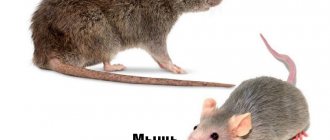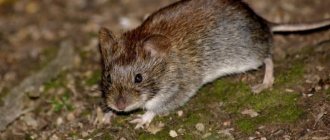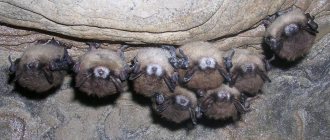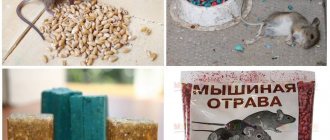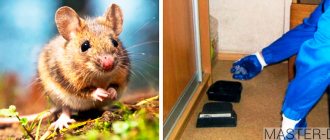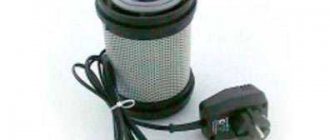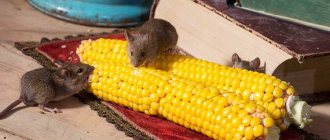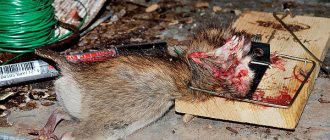Smart home 2
0
With the onset of cold weather, rodents leave the fields and begin to attack private houses. There are many problems that they bring with them: they spoil food, chew wires, make holes in layers of insulation, walls and furniture, and leave marks and an unpleasant odor in the places where they stay. In addition to this, rodents are carriers of many dangerous diseases. Having settled well, mice begin to multiply quickly, so it is necessary to start fighting them as soon as possible. Experts advise building defense on all fronts, starting with prevention.
Causes and consequences of rodents in the house
There is always food and warmth near a person - rodents have figured this out a very long time ago. Protection from the wind, some goodies - everything you need for a quiet life and reproduction. And pests are not picky when it comes to food; both dry cereal and oily rags are suitable for them. Nature has awarded individuals with incredible vitality and the ability to digest almost any food, including cellulose, cotton wool and other objects inedible for humans.
To get rid of mice, you first need to carry out prevention - assess the state of cleanliness, the presence of secluded nesting places and the likelihood of individuals entering from the outside. To understand why mice in the house are bad, you should familiarize yourself with the possible consequences of the neighborhood:
- Rodents are carriers of diseases such as plague, typhoid, rabies, and cholera.
- Pests are not only capable of destroying stocks of vegetables, cereals and other food, but can irrevocably spoil stored flour and pasta. If the mouse has left marks in the form of feces or urine, the food becomes contaminated and should not be consumed.
- Wires, power cables, casing, machinery and building materials are at risk. It is not difficult for a large mouse to gnaw a hole in concrete. Gnawed wires will lead to a short circuit, which causes a fire, and if pests get into the car, they can damage the mechanisms.
- Furniture, clothing, shoes are at risk - everything that might be of interest and could be eaten or chewed on. Gray animals will gladly tear a fur coat into pieces to line their nest.
- The smell of mice cannot be confused with anything else. This aroma lasts for a very long time, and as long as domestic mice live near humans, their smell cannot be removed.
Mice in the house make themselves known by black beads of feces, chewed bags, and an unpleasant odor. It is extremely rare to see them, but this only happens when there are many “neighbors”; usually rodents prefer to work and live secretly. If you find at least one gray pest, you need to urgently get rid of the mice. Otherwise the problems will soon become significant. One female vole can produce offspring over the summer that will fill a small country house. And here the gray mass will make itself felt by complete damage to property, vegetable gardens and garden plantings.
Chemicals
Poison for mice
Among the various control methods, poisons and toxic chemicals are used quite often. The principle of action is that an animal that has consumed food with poison begins to bleed internally. There is a disruption in the functioning of the kidneys, liver and other organs. The rodent dies. The pest does not always die immediately after the “deadly meal”, so it is important to provide round-the-clock access to the bait.
We suggest you read: Is boric acid harmful to humans, what will happen if you drink boric acid, danger
Along with the unsightly sight, this also provides a nauseating aroma. Mouse carcasses should be disposed of without delay. The advantages of the method are that the poison can be purchased at any hardware store.
Please note that if a rodent eats the bait and goes to die in its hole, then you will have to feel the unpleasant smell that the decomposing corpse of the mouse will emit. In addition, rodents have the ability to quickly adapt to poisons, so they will have to be changed from time to time.
Here are some of the most effective substances with poisonous properties:
- "Mouse Death"
- "Rat Death"
- "Storm".
- Ratron.
- Havoc Rat {amp}amp; Mouse Bait.
Lures
When using them, it is recommended to adhere to hygiene rules, in particular, thoroughly wash your hands and use protective clothing. Smoking, drinking and eating are prohibited in the room or barn where they are used. Such means include:
- "Rodentoff".
- "Otkrys."
- Ratron.
- Euroqand.
- "Nutcracker".
Aerosols and sprays
The peculiarity of this method is that it sprays an aroma that small rodents cannot tolerate. Sprays contain toxic substances that repel rats and mice. The contents of the aerosols are applied to wires, plastic and other surfaces for 14 days. After two weeks, the treatment process must be repeated. The advantage is that the method does not harm the surrounding nature and animals.
The peculiarities of the spray are the need for repeated use. After a certain period, re-processing will be required. Known drugs:
- Marder-Schutz-Spray.
- Pestro.
Traditional methods of getting rid of mice in the house
If there are grandparents in the family over the age of 70, they know exactly how to get rid of mice. In their years there was no Internet, therefore all methods were transmitted only by word of mouth and ineffective ones were eliminated during the transmission process. We offer the most effective folk remedies for mice that will help cope with the problem today:
- Natural repellents. These are herbs with a strong odor that is unpleasant to rodents. Suitable plants are tansy, wild rosemary, pyrethrum, wormwood. Place bunches of fresh plants in the corners, change them as they dry. Wormwood smoke helps well; they need to fumigate the room. A mixture of bay leaves and vinegar is also recommended. Pour a couple of laurel leaves with acetic acid, place bowls in the areas where rodents are located; mice cannot stand the strong smell and leave.
- Baits with poison. Flour, oat bran and other products are suitable as goodies. Mix with gypsum (1:1), place in cups under burrows or “on paths” for mice to pass through. You should also leave water in a visible place. After tasting the gypsum mixture, the mice will want to drink. It is not difficult to predict what will happen as a result - the plaster will harden in the stomach and there will be no mice. But such a bait only works once, social animals may not approach a treat with the same smell, and the appetizing component will have to be changed. If the option with plaster seems monstrous, finely chopped wine corks will help. You can also mix the fractions with food and put them on – the effect is the same. It is worth knowing that the method is aimed at significant extermination, so the dead carcasses will need to be collected, removed and burned.
- Traps. You can buy mousetraps or make your own. Add oil and some food to a wide-necked plastic bottle. The mouse needs to be able to get into the container, but not be able to get out. To get rid of mice, you need a lot of traps, empty them when they are full and set them again. The method is fail-safe; house mice climb into jars in droves.
- Strong chemical smell. Turpentine, formalin, kerosene - all these aromas frighten pests. You need to lubricate the seams of walls and baseboards generously, so this method is not suitable for residential premises.
- Uncomfortable travel conditions. Folk remedies for mice in this case offer a lot of options: sprinkle ash, red pepper, crushed glass on the baseboards. Contact of the exposed skin of the paws with substances causes pain, and rodents will also lick the ash and pepper, which will only aggravate the unpleasant effect.
- Glue trap. You need cardboard or a board, glue with a sufficient shelf life. You can take special glue or Moment, mixing in a little flour. Spread the cardboard with glue, place it in the area where the rodents are located - after a while, check the trap, refresh the glue or throw out the dead animal (it is better to burn it).
Traps are good for their effectiveness, but when rodents get into the cardboard, they make a lot of noise in the mousetrap. In addition, if there are mice in the house, then there may be a rat somewhere, and a mousetrap cannot contain it, so more powerful methods are needed.
The biological method is a cat. This is a natural enemy of rodents that works always and anywhere. But there are limitations here too:
- domestic cats have long lost their hunting skills and may themselves be afraid of mice, rather than catching them;
- kittens are not able to catch and kill an adult;
- Not even every adult cat can handle a rat;
- rodents respond by attacking and biting - this can cause illness in the pet;
- To get rid of mice, you need your own cat; someone else’s cat is unlikely to catch pests in an unfamiliar environment.
If it is not possible to have a cat, for example, at the dacha in the summer, you should feed your neighbor Murzik. A little affection and the cat will repay you by exterminating the entire mouse family in the vicinity. As a rule, village or rural cats do not hunt alone, so they can cope even with large individuals and numerous litters. This option is better than all folk remedies for mice.
Pied Animals
Pets are used to kill pests. The most famous rat catchers are cats. Predators hunt small animals and quickly destroy them. Residents of private houses resort to the help of mustachios. The kitten must be born to a rat-catcher cat. His mother will teach him to look for and catch mice.
Cats living in apartments rarely hunt. They have enough food and do not need to hunt for food. Pedigree cats most often do not know how to catch mice. But their owners claim that the cat smell discourages pests from settling in the house.
Interesting!
Dogs are wonderful rat catchers. Terriers monitor the safety of the home. They are able to quickly find an enemy and kill him with one bite.
Ratcatchers include snakes. The snake strangles the victim and then eats it.
It is difficult to choose the most effective remedy for rats and mice. Everyone chooses for themselves the best method of exterminating pests. Some people prefer to use store-bought chemicals. Others resort to catching mice using traps. But it’s better not to wait for uninvited guests to appear and take preventive measures. Do wet cleaning of the premises, seal cracks in the floors, and prevent debris from appearing near the entrance.
How to get rid of mouse odor
Dying from poisons, bait or falling into a trap, a large mouse can crawl into a secluded corner from where it is not possible to get it. And if the bait is generous, then the massive destruction will fill the house with the smell of disappearing carcasses. First, you need to clean the room as much as possible from rodents, inspect from the basement to the attic, from the pantry to the balcony. After removing and burning the rodents, begin cleaning.
How to get rid of the smell if there were mice in the house:
- Rinse floors, walls, furniture and ceilings with vinegar water. For 5 liters of warm water, take 6 tbsp. l. acetic acid. The essence will quickly eliminate all residual odors.
- After drying the surface, treat it with hydrogen peroxide. This is an antiseptic that destroys microbes, so there is no need to spare peroxide.
- If there are residual aroma, potassium permanganate will help. Dilute the crystals in water, achieving a pink color, and process the surfaces. Wear gloves on your hands to avoid burning your skin. The composition will kill germs and odors in hard-to-reach places; you need to take the liquid into a bulb or spray bottle and generously spray the cracks and joints. After drying, treat with peroxide.
Finally eliminates germs and bleach smell. Whiteness or regular chlorine soda will do. Dilute in water and rinse all surfaces, now the apartment is clean and free of germs. Sometimes house mice stomp on the suspended ceiling, leaving their marks there. To get rid of the smell, but not blur the surface, folk remedies for mice will help:
- whitewash the ceilings with lime and blue;
- add copper sulfate to the chalk white and whiten the base;
- dilute quicklime in water, add pure chlorine and a little blue – the composition kills all microbes.
Lime is a natural antiseptic, and when supplemented with chlorine or blue, it greatly enhances its properties.
Elder
Not only mice, but also rats cannot stand the smell of elderberry. The roots of this plant secrete hydrocyanic acid, which is especially dangerous for rodents. Therefore, pests never settle in elderberry fields. People have known about the valuable properties of elderberry for hundreds of years and planted it near warehouses, barns and sheds.
No harmful rodents were observed in houses lined with elderberry. In addition, gardeners have more than once been convinced from their own experience that grass saves not only from mice, but also from insects.
Modern ways to get rid of mice
Having figured out what house mice are afraid of, you can try all the methods in order or buy a mouse repeller. This is a universal remedy that helps get rid of mice in any room and in any quantity. For conservationists and anyone who does not want to deal with the removal and burning of carcasses, an ultrasonic repeller is the only possible option. There are many advantages of using:
- This is a humane way. The mouse repeller does not kill, but creates unbearable living conditions. The device operates on the principle of generating and transmitting a constantly changing audio track. In the understanding of rodents, a mouse repeller is a danger signal. The ear of a person and a pet does not hear sounds, but for pests it is the same as the roar of an airplane turbine right next to the ear. And the roar is not one-time, but constant and continuous. It is physically impossible to be in such conditions; the pests will go away on their own.
- No animal deaths. It turns out that mice do not appear in the house due to discomfort. They do not die in walls, thicker ceilings, under floors or suspended ceilings, they go away.
- There is no smell or other irritating effects. This property allows you to install devices in residential, non-residential premises, under a roof or on the ground. The basic rule is to select a module of the required power and calculate the installation area in advance.
- Harmless to all living beings. The ultrasonic repeller works inaudibly for humans, dogs, cats and other living creatures. A pet rat or other rodent may experience discomfort, but here you have to choose - hordes of gray pests or temporary inconvenience of your pet.
- No adaptation. Unlike bait, poison, or a mousetrap, an ultrasonic repeller cannot be bypassed and not fall under its influence. The device is reusable and is used both for prevention and to eliminate the problem.
- Mice will never appear in the house again. Preventative activation of the device is only necessary for apartments and houses located near granaries, trash cans, and other open food facilities. The regularity of room treatment is infrequent; a day's worth of cleaning will suffice after 2-3 months.
- Efficiency. The devices work 100% of the time. To expel a large population, you need to wait a little (2-3 days of continuous operation); if we are talking about large areas of elevators, then constant long-term operation of the devices will be required, but the repellers will drive out the mice forever.
To get rid of mice, you don’t need to collect wormwood, smear the walls with kerosene or scatter bait. In the latter case, there is a danger that the carcass will be eaten by a pet or a child will be injured while looking at a small mouse stuck to the cardboard. The price of repellers is higher than that of folk remedies, but the devices have been working for decades. And if you choose a battery-powered device, you can get rid of mice in chests and closets, in the garage, in the attic and anywhere there is no connection to the electrical network. If you don’t know what kind of unit you need, an experienced manager will help. Call, a specialist will select a device in accordance with the user’s needs and capabilities.
Blackroot
Blackroot is also called rat racer. The plant was adopted in the fight against mice and rats hundreds of years ago. Moreover, it is used in several formats, both dried and fresh: a strong decoction of the roots, freshly squeezed juice or crushed rhizome.
Placing an armful of blackroot in the house will repel small pests for a long time. The plant, like elderberry, is considered poisonous, so you should be careful with it in kitchens. The odors coming from blackroot are felt only by mice, but for people it is neutral.
You can place the plant in the attic, closet or underground. If you need to use black root in the local area, the plant must first be scalded. In this case, small seeds open, which mice are so afraid of. You can also simply plant a rat racer on your site. 20 plants are enough for 5 acres.
Boric acid
The product has a barely perceptible odor: household members will not notice it, but it is unpleasant to mice. In addition, after contact with boric acid, it remains on the fur of pests. The animal will attempt to get rid of the unpleasant odor by licking the body with its tongue.
Once in the stomach, boric acid poisons the body and the mice subsequently die. If you have a cat or dog in your home, then this product should be used with extreme caution, avoiding contact of the dangerous composition with pets.
Essential oils
Essential oils are an equally effective alternative to herbs. The latter have a more pronounced odor, especially concentrated extracts. To repel pests, simply soak a swab or gauze in oil and place them in mouse habitats.
The smell settles on interior items and lingers in the room for a long time, continuing to repel pests. Peppermint and Japanese mint oils are considered the most effective. They are used according to the following recipes:
- Add 15 drops of Japanese mint and 10 ml of medical or industrial alcohol to 400 ml of water. Mix the components thoroughly until completely dissolved: there should be no sediment. Spray with a spray bottle in the corners of rooms and in places where mice gather.
- Mix 20 drops of peppermint and 50 ml of any mineral or vegetable oil. We soak the swab in the resulting mixture and treat corners, baseboards and other problem areas. The mixture must be stored in a tightly closed container (no more than six months).
Bleaching
The smell of bleach can drive away annoying rodents. It is better to use it as a detergent, treating not only floors, but also going well onto baseboards. On sale you can find both bleach in its pure form and diluted with soap or powder. For greater efficiency, the first option is preferable.
But in addition to mice, allergy sufferers who cannot tolerate the unpleasant specific smell of chlorine can also suffer. In this case, you can mix it with flavorings. The aroma will change for the better for humans, but will remain just as unpleasant for mice.
Mint
This is one of the most famous and widely sought after plants. A properly dried bush or concentrated mint tincture with alcohol will repel not only mice, but also rats. If you place a small bunch of this plant next to food, rodents will avoid your supplies.
The smell of mint is pronounced even for humans, and animals go crazy from it and try to leave the room in horror. The aroma clogs the lungs of pests and prevents them from breathing. The effect of mint in mice is comparable to asthma attacks in humans.
Sagebrush
Wormwood planted around the perimeter of the garden protects the harvest with its bitter, tart and at the same time slightly pleasant aroma. Sheaves are spread with grass to repel small pests from the bread. Mice will never go near a tree bound with wormwood.
To repel pests in the house, the plant is placed in underground spaces, closets and cellars. The smell, unpleasant for pests, repels them for a long time, but at the same time, many people cannot tolerate the aromas of wormwood. Therefore, before adopting this herb, it would be useful to conduct a trial acquaintance with it by rubbing your arm or leg with a bush. If the area does not turn red, then there is no allergy.

